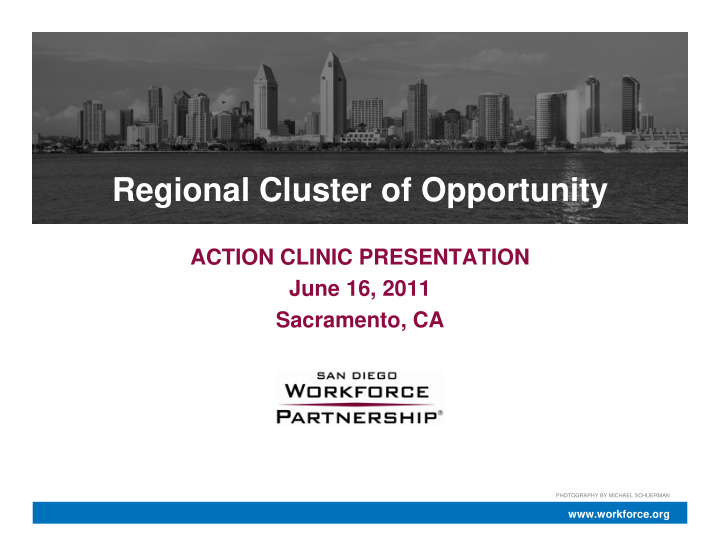



Regional Cluster of Opportunity ACTION CLINIC PRESENTATION June 16, 2011 Sacramento, CA PHOTOGRAPHY BY MICHAEL SCHUERMAN www.workforce.org
Identifying Our Regional Industry Clusters of Opportunity Within Healthcare Information Technology 1) Executive interviews with leaders of major employers in the region 2) Surveys of HR and hiring managers from a large sample HIT & IT organizations 3) Roundtable meetings w/regional industry stakeholders PHOTOGRAPHY BY MICHAEL SCHUERMAN www.workforce.org
Key Sectors • Significant contributors to growth : IT services, life sciences, healthcare, hardware, and wireless technologies • Mature sectors : Electronic Medical Records (EMR), data storage and software • Emergent sectors : Healthcare Information Exchange (HIE,) data analytics, informatics, “Glueware” (interfaces that connect systems,) mobile health, wireless health www.workforce.org
Employer Engagement • Research activities • Executive interview • Surveys • Roundtable discussions • Networking activities • Personal communication with established community partners in business, education & the non- profit sectors PHOTOGRAPHY BY MICHAEL SCHUERMAN www.workforce.org
Survey of Randomly Selected Employers • 207+ employers – – SD healthcare firms (hospitals, clinics, private offices, ambulatory care centers) – SD IT firms (hardware, software, internet, networks, communications firms) www.workforce.org
Getting Employers to the Workforce Development “Table” Key = employer interest. “In essence, a critical mass of employers needing workers, educators who think they have solutions, and supportive funders will catalyze a workforce development effort.” www.workforce.org
Leveraging Implementation Resources & Commitments • Employers & industry • Participation in representatives –will regular meetings influence: • Representation in • Economic Dev. plan cluster industry for HIT cluster roundtables • Investment of • Review & response to implementation funds meeting reports, development plans, etc. www.workforce.org
Collaborative Planning • Ongoing, collaborative work groups- supportive business, economic & workforce development leaders • Leadership from local WIBs & econ dev. orgs • Educational institutions esp. community colleges: – Understanding needs of target population – Leveraging & expanding current HIT program development PHOTOGRAPHY BY MICHAEL SCHUERMAN www.workforce.org
Achieving Sustainable Systems Change • Growing regional collaboration breaking down barriers between sectors previously perceived as independent (Healthcare & IT) • Leveraging Regional Clusters planning work to spur policy change to support HIT industry • SDWP: � Disseminate project reports � Convene HIT roundtable www.workforce.org
Conclusions • Real systems change not yet here • Workforce development follows industry need - Significant change in industry demand for new skills & new workers not yet identified • As healthcare more wireless & more “glueware,” SD’s competitive advantages will catalyze systems change in use & delivery of healthcare technology • Systems change w/in industry will require similar workforce development changes • Until industry change, new system = sector-focused, intermediary-led economic development • Not new funding but greater interaction between employers, educators/trainers, policy makers & workforce development funding. www.workforce.org
Recommend
More recommend